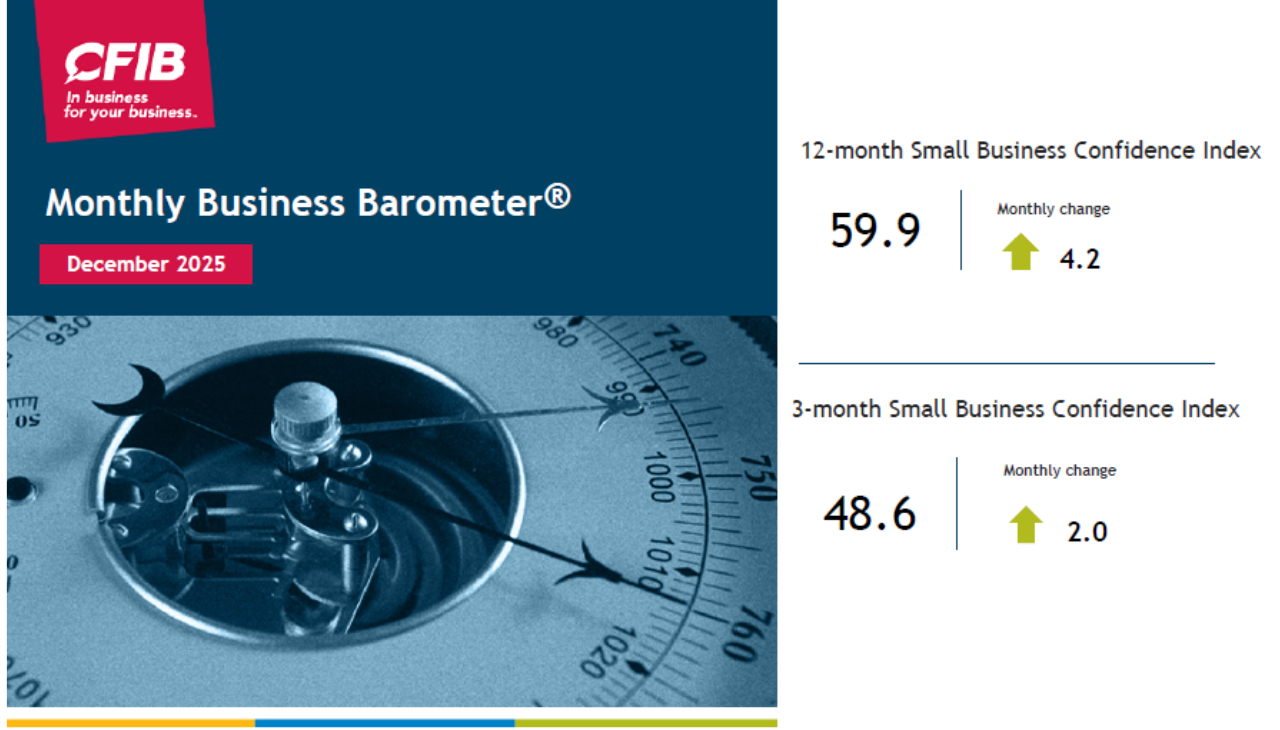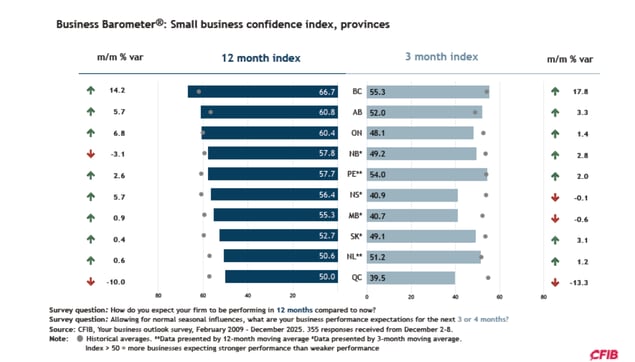
December 2025 Results
Key takeaways
- Small business optimism continued to recover in December, standing close to the 60-mark;
- Challenges and uncertainty define 2025 for many small businesses;
- More than half of small businesses still report insufficient demand.
Small business optimism in Canada
CFIB’s Business Barometer® long-term index, which is based on 12-month forward expectations for business performance, reached 59.9—an increase of 4.2 points from November. The short-term optimism index, based on a 3-month outlook, rose by 2.0 points to 48.6, indicating only a modest improvement.
Provincial picture
The long-term confidence gained traction in British Columbia, Ontario and Alberta−all registering levels on or above 60. Quebec lost all the confidence gained last month and dropped to 50.0 - the lowest reading among all provinces. Short-term confidence is significantly lower in all provinces showing economic uncertainty to start 2026.

Sectoral overview
Long-term confidence was somewhat stable overall. The biggest drops in optimism were registered in hospitality and construction, not surprisingly as they are somewhat seasonal industries. The health and education, retail and the insurance sectors gained momentum.

For more information about retail sector's expectations, staffing and price plans, visit our new dashboard.
State of business health
Business sentiment is mixed about 2025. Many described the current year as challenging, uncertain, or difficult, while others use words such as ‘growing’, ‘busy’, ‘great’. A significant share of respondents depict the instability of the economy as ‘rollercoaster’, ‘frustrating’ and ‘uncertain’.
The current state of business health continues to be below its historical average but has improved in December.
Inflation indicators
The average price increase increased slightly to 2.6% in December, while the average wage increase remained steady at 2.2% for the fourth consecutive month.
Other indicators
Full-time staffing plans show a continuingly weak labour market, with more employers looking to reduce staffing (16%) than to hire (14%), illustrating a negative share of net staffing intentions for the fourth consecutive month.
Insufficient demand remains the primary barrier to business and production expansion (as reported by 54% of SMEs), about 16 points above its historical average. Key cost constraints hindering growth include tax and regulatory expenses (62%), wage costs (60%), and insurance costs (58%).
Methodology
These results are based on 355 responses received from December 2 to 8 from a stratified random sample of CFIB members to a controlled-access web survey. Findings are statistically accurate to +/- 5.2 per cent 19 times in 20. Every new month, the entire series of indicators is recalculated for the previous month to include all survey responses received in that previous month. Measured on a scale between 0 and 100, an index above 50 means owners expecting their business’s performance to be stronger over the next three or 12 months outnumber those expecting weaker performance.
The next Business Barometer will be released on January 22, 2026. We will publish shortly our release dates for 2026.
For more information about the retail sector, see the dashboard below. It presents long and short term optimism, current state of business health, staffing plans, price and wage plans, as well as main costs and limitations for retail firms.
For regional information about business optimism, price plans, limitations and main cost constraints for SMEs, please visit: the Business Barometer, 2024 Retrospective. We will release the 2025 Retrospective in the coming days.
Related Documents
| Release Date | Report | Download |
|---|---|---|
| December 2025 | Business Barometer® National Summary |
PDF (2.6 MB) |
| December 2025 | Business Barometer® Provincial Summaries |
PDF (1.3 MB) |
| December 2025 | Business Barometer® Industry Summaries |
PDF (1.0 MB) |
| December 2025 | Business Barometer® Data Table |
Excel (600 KB) |
| January 2024 | Current Survey |
PDF (603 KB) |
| April 2020 | Survey - before 2024 |
PDF (84 KB) |




 Share Article
Share Article
 Print Article
Print Article
